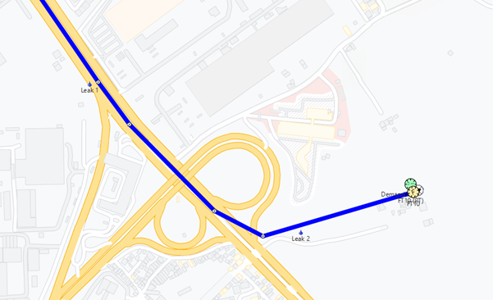How can water utilities stop losses in transmission?
Across Europe, the water that leaves treatment plants doesn’t always reach customers. On average, 25% of all water supplied across the continent is lost through leaks and bursts.1 In some regions, that figure is far higher. Italy loses more than 40 percent of its potable water, with some southern areas exceeding 60 percent.2
As climate change intensifies droughts, these losses are becoming critical. Even well-managed networks are struggling with aging infrastructure, underinvestment and growing urban demand. The challenge for midstream is simple to state but difficult to solve: keep water in the pipes.
In this second blog from our “From source to tap” series, Business Development Director for water Martin Duff looks midstream at how utilities can strengthen the transmission network using modern leak and theft detection technologies, covering:
- Why leaks are still such a major issue in Europe
- How technology can improve leak detection
- How leak detection helps prevent water theft
- Why midstream resilience matters
 Why are leaks still such a major issue in Europe?
Why are leaks still such a major issue in Europe?
Many of Europe’s pipelines predate the 20th century. Old materials, fluctuating pressure and ground movement all contribute to leaks and efforts to replace assets are ongoing.
London, for example, is investing over £400 million to future-proof its water supply,3 but in some regions, replacement rates are too slow to make a meaningful difference. Slovakia’s network renewals have maintained, rather than reduced, overall leakage levels.4
There’s also inconsistency in how leakage is reported across the continent. Some utilities use different methods or metrics, making it difficult to compare progress.5 The result is that Europe’s real water loss may be higher than published data suggests.
How can technology improve leak detection?
Traditional leak detection often relies on acoustic or flow-based methods, which are useful for slow leaks but may miss new bursts or events on large-diameter mains. The negative pressure wave (NPW) technique detects leaks as they happen by identifying the transient pressure wave that travels through the pipeline when a rupture or theft occurs (see Figure 1).
Figure 1: Transient monitoring with high resolution negative pressure wave data
In one UK case, a utility operating an aging trunk main network faced frequent leaks and unplanned interruptions. Atmos International installed battery-powered instrumentation units that acted as both leak detection and telemetry devices. During calibration trials, the system located simulated leaks within ±40 meters of their true position on a 20 km section. Even in complex networks with multiple valves and offtakes, the technology achieved high accuracy without needing mains power or extensive communications infrastructure.
Result: the utility gained a reliable early warning system for new leaks, reducing water loss and response times in an environment where every cubic meter counts.
How does leak detection help prevent water theft?
Water theft is an under-reported but growing problem, particularly where scarcity and cost pressures are rising. Just as oil theft in Europe surged by 400% between 2013 and 2016,6 water theft is now emerging as a risk in regions facing drought.7,8

Figure 2: The number of theft related events recorded by Concawe since 20109
In Europe, theft of water isn’t new. Italy’s “Water Mafia” once controlled scarce supplies in the south7 and illegal irrigation remains common in agriculture. In Spain and Greece, farmers have been arrested for tapping unregistered wells to maintain crops during drought.8 These examples show how theft can quickly scale from isolated cases to systemic losses when supply tightens.
The challenge for utilities is that theft events often mimic normal operational activity. Pressure and flow fluctuations from legitimate usage can mask illegal tapping, especially on trunk mains with few sensors or no direct supervision.
When a thief connects to a pipeline, a rapid pressure change travels in both directions along the pipe. Atmos’ NPW technology can identify these events and a striking example of this approach can be found in our work in Brazil.
When a thief connects to a pipeline, a rapid pressure change travels in both directions along the pipe. Atmos’ NPW technology can identify these events and a striking example of this approach can be found in our work in Brazil.
Case study: detecting theft in Brazil’s trunk mains
In a pilot project in Brazil, a water utility was experiencing non-revenue water losses exceeding 60%. Much of the loss was suspected to come from unauthorized connections along a 12 km trunk main serving both residential and institutional users.


Figure 3: The 12 km monitored section of the customer's trunk mains pipeline (left) and the calculated leak locations (right)
Atmos deployed five NPW data loggers using existing pressure and flow meters at key points. Several theft events were then simulated to test the system’s accuracy. The results were clear:
- All simulated thefts were detected successfully
- Locations were calculated to within 1-2% of the total pipeline length
- The network’s dynamic pressure profile proved suitable for continuous monitoring
These findings confirmed that an online leak and theft detection system could not only locate theft but also alert operators in near real time, allowing faster response and investigation.
This case study demonstrates how the same NPW technology that identifies leaks can also detect theft, helping utilities recover lost revenue and strengthen supply security.
 Why midstream resilience matters
Why midstream resilience matters
The midstream network, the pipes between treatment plants and customers, is where most water losses occur. Detecting leaks and thefts quickly protects supply, reduces treatment waste and strengthens public confidence.
Atmos’ technology helps utilities build midstream resilience through accurate, real-time detection systems that keep water where it belongs: in the network.
Next up: Downstream - reducing water demand
In the final article, we move downstream to explore how utilities can manage water demand through smart metering, education, and customer engagement.
References
2 https://www.statista.com/statistics/1405063/water-lost-to-leaks-share-italy
5 https://www.eureau.org/resources/position-papers/7456-eureau-position-on-leakage-reporting/file
6 https://commonslibrary.parliament.uk/research-briefings/sn02106/
7 https://www.theguardian.com/world/2002/aug/18/philipwillan.theobserver
